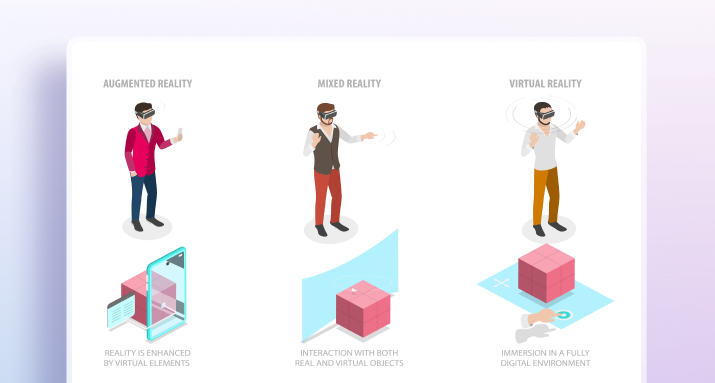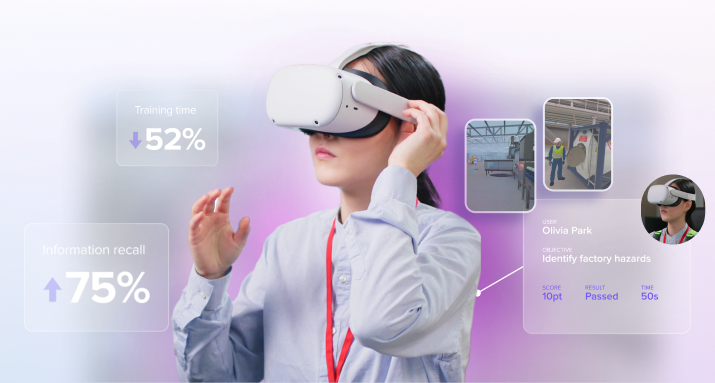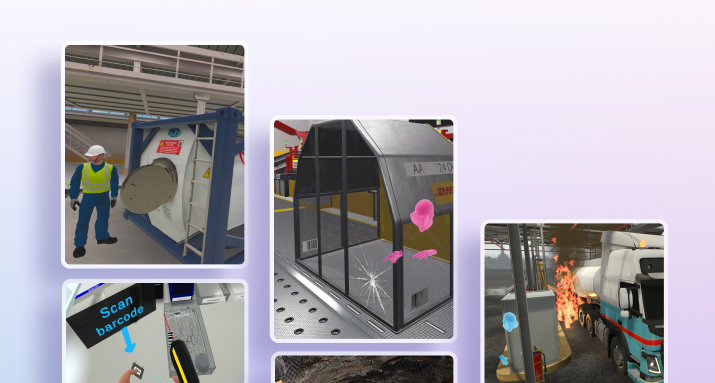
In this article
How immersive learning works
Key differences between XR technologies
Business uses of VR
Benefits of immersive learning
Measuring the effectiveness of immersive learning
Immersive learning is transforming training by leveraging advanced XR technologies such as Virtual Reality (VR), Augmented Reality (AR), and Mixed Reality (MR) to create engaging and interactive experiences. For businesses, understanding the advantages and applications of immersive learning is crucial for enhancing employee development and operational efficiency. This article addresses frequently asked questions about immersive learning, exploring its benefits, use cases, and impact on corporate training programs and overall business performance.
1. What is immersive learning?
Immersive learning in the business context uses immersive technologies to create simulated environments for employees. This approach includes VR, AR, and MR, providing hands-on, experiential learning opportunities that enhance retention, understanding, and application of knowledge in a professional setting.
2. How does immersive learning work?
Immersive learning integrates digital simulations with real-world scenarios, allowing employees to interact with content in meaningful ways. For instance, in a VR setup, employees might use a headset to enter a virtual environment where they can practice skills, conduct experiments, or navigate complex systems safely and efficiently.
3. What is the difference between VR, AR, and MR in business learning?
Virtual Reality (VR) completely immerses the user in a digital environment, separating them from the physical world. Augmented Reality (AR) overlays digital content onto the real world, enhancing physical surroundings with additional information. Mixed Reality (MR) blends physical and digital worlds, allowing interaction with both real and virtual elements simultaneously.
Learn more on differences between XR technologies
4. How is VR used in business training?
VR is used in business training to create immersive simulations that allow employees to explore environments and scenarios that would be impractical or impossible in real life. Examples include virtual safety drills, equipment handling simulations, or remote training.
5. What equipment is needed for immersive learning in businesses?
The equipment required for immersive learning varies based on the technology used. VR headsets provide a fully immersive environment, engaging users with visual and auditory experiences. AR devices, including smartphones, tablets, and AR glasses, overlay digital information onto the real world, enhancing perception. MR headsets are advanced devices that combine AR and VR capabilities, allowing interaction with both real and virtual elements simultaneously.
6. What are the benefits of immersive learning for businesses?
Immersive learning enhances engagement by capturing employees’ attention through interactive and visually stimulating content. It improves retention by allowing employees to experience concepts firsthand, enabling them to retain information more effectively. This method also provides a safe practice environment where employees can practice skills and make mistakes without real-world consequences. Additionally, immersive learning adapts to individual learning styles and paces, offering a personalized and customized learning experience.
Learn more on benefits of VR training
7. What are some examples of immersive learning applications in businesses?
Immersive learning is utilized in various industries to enhance training and development. In healthcare, it includes simulated surgeries and patient interactions for medical professionals. In manufacturing, it focuses on training employees in machinery operation and safety protocols. In the oil and gas industry, it involves emergency response drills and complex machinery operation training.
Learn more on VR training use cases
8. Can immersive learning be used for soft skills training in businesses?
Yes, immersive learning is highly effective for soft skills training. VR simulations can replicate social scenarios where employees can practice communication, teamwork, leadership, and problem-solving skills. For instance, VR can simulate a customer service interaction, enabling employees to practice resolving issues with virtual customers.
Explore soft skills content on the Portico VR Content Library
9. How do businesses measure the effectiveness of immersive learning?
Effectiveness can be measured through various metrics, including employee engagement, which is assessed by the time spent on the learning platform and interaction rates. Knowledge retention is evaluated through pre- and post-assessment scores. Skill application is gauged by performance in practical scenarios after training. Additionally, feedback is collected from employees through forms to gather insights on the training experience.
10. How does immersive learning impact business training and overall performance?
Immersive learning is revolutionizing business training with realistic simulations for onboarding, safety, technical skills, and compliance. VR boosts engagement and retention, accelerating time to competency. VR also enhances safety and compliance, reducing accidents and improving protocol adherence. Cost savings and efficiency are achieved by minimizing the need for physical equipment and reducing downtime. Detailed analytics track performance, allowing for data-driven improvements in training programs.
Contact us for more insights on how immersive learning can elevate your business training programs.



